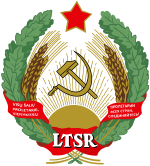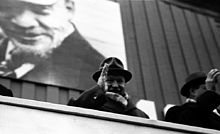Communist Party of Lithuania
This article needs additional citations for verification. (November 2017) |
Communist Party of Lithuania Lietuvos komunistų partija | |
|---|---|
| First Secretary | Mykolas Burokevičius (last) |
| Founded | 1918 |
| Banned | 1991 |
| Succeeded by | Democratic Labour Party of Lithuania |
| Headquarters | Vilnius |
| Newspaper | Tiesa |
| Ideology | Communism Marxism–Leninism |
| International affiliation | Communist International |
| Colours | Red |
| Election symbol | |
 | |
You can help expand this article with text translated from the corresponding article in Lithuanian. (November 2017) Click [show] for important translation instructions.
|

The Communist Party of Lithuania (Template:Lang-lt, Template:Lang-ru) was a communist party in Lithuania, established in early October 1918. The party was banned in 1991.
History
The party was working illegally until 1940. During the same year, the party amalgamated with the Communist Party of the Soviet Union (Bolsheviks). By the time of the formation of the Lithuanian SSR, the Communist Party of Lithuania (LKP) was headed by Antanas Sniečkus. In 1940, the LKP merged into the CPSU(b). The territorial organisation of the party in Lithuania was called Communist Party of Lithuania (bolshevik) (LK(b)P). In the Lithuanian territorial organisation, the first secretary of the Central Committee of the party (always a Lithuanian) was de facto governor of the country. The second secretary was always a Moscow-appointed Russian. In 1952 the name of the old Lithuanian party, LKP, was re-adopted.
On 24 December 1989,[1] during mass protests of the Singing Revolution against the Soviet Union in Lithuania, the party declared itself independent from Communist Party of the Soviet Union. In 1990, the Communist Party of Lithuania evolved into the Democratic Labour Party of Lithuania, which in turn was later merged with Social Democratic Party of Lithuania under the latter's name; but with leadership dominated by ex-communists.
The remainder of the Communist Party of Lithuania ('on platform of Communist Party of the Soviet Union') existed in 1990-91 under leadership of Mykolas Burokevičius after the "traditional" party declared independence from its Soviet Union counterpart. The party played a major role in the January 1991 Events in Lithuania and initiating the creation of the National Salvation Committee. The Communist Party of Lithuania was eventually banned in August 1991. Although still illegal, the Communist Party of Lithuania is affiliated to the Union of Communist Parties — Communist Party of the Soviet Union (UCP-CPSU) headed by Gennady Zyuganov.
| Party membership[1] | |
|---|---|
| Year | Members |
| 1930 | 650 |
| 1936 | 1,942 |
| 1940 | 1,741 |
| 1941 | 4,620 |
| 1945 | 3,540 |
| 1950 | 27,800 |
| 1955 | 35,500 |
| 1960 | 54,300 |
| 1965 | 86,400 |
| 1970 | 116,600 |
| 1975 | 140,200 |
| 1980 | 165,800 |
First Secretaries of the Communist Party of Lithuania

| No. | Picture | Name
(Birth–Death) |
Took office | Left office | Political party |
|---|---|---|---|---|---|
| First Secretary | |||||
| style="background:Template:Workers' Party of Korea/meta/color; color:white;" |1 | 
|
Antanas Sniečkus
(1903-1974) |
21 July 1940 | 22 January 1974 | CPL/CPSU |
| style="background:Template:Workers' Party of Korea/meta/color; color:white;" |2 | 
|
Valerijus Charazovas
(1918-2013) |
22 January 1974 | 18 February 1974 | CPL/CPSU |
| style="background:Template:Workers' Party of Korea/meta/color; color:white;" |3 | 
|
Petras Griškevičius
(1924-1987) |
18 February 1974 | 14 November 1987 | CPL/CPSU |
| style="background:Template:Workers' Party of Korea/meta/color; color:white;" |4 | 
|
Nikolajus Mitkinas
(1929-1998) |
14 November 1987 | 1 December 1987 | CPL/CPSU |
| style="background:Template:Workers' Party of Korea/meta/color; color:white;" |5 | 
|
Ringaudas Songaila
(1929-2019) |
1 December 1987 | 19 October 1988 | CPL/CPSU |
| style="background:Template:Workers' Party of Korea/meta/color; color:white;" |6 | 
|
Algirdas Brazauskas
(1932-2010) |
19 October 1988 | 23 December 1989 | CPL/CPSU |
| style="background:Template:Workers' Party of Korea/meta/color; color:white;" |7 | 
|
Mykolas Burokevičius
(1927-2016) |
23 December 1989 | 24 August 1991 | CPL/CPSU |
Second Secretaries of the Communist Party of Lithuania
- Icikas Meskupas-Adomas February 9, 1941 – March 13, 1942
- Vladas Niunka April 1944-December 30, 1944
- Alexander Isachenko December 30, 1944–November 24, 1946
- Alexander Trofimov November 24, 1946–September 22, 1952
- Vasily Aronov September 25, 1952–June 11, 1953
- Motiejus Šumauskas February 1954–January 24, 1956
- Boris Sharkov January 28, 1956–September 27, 1961
- Boris Popov September 30, 1961 – April 13, 1967
- Valery Khazarov April 13, 1967 – December 10, 1978
- Nikolay Dubenko December 11, 1978 – September 17, 1986
- Nikolay Mitkin September 17, 1986 – December 9, 1988
- Vladimir Beryozov December 9, 1988 – 1990
Congresses of the Communist Party of Lithuania
| Congress | Date | Delegates
Voting + advisory |
Notes |
|---|---|---|---|
| 1st | October 1–3, 1918 | 34 | Took place illegally in Vilnius |
| 2nd | March 4–6, 1919 | 159 + 10 | Joint congress with the Communist Party of Byelorussia; Established the Communist Party (Bolsheviks) of Lithuania and Belorussia |
| 3rd | October 24–29, 1921 | 12 | Took place illegally in Königsberg |
| 4th | July 17–21, 1924 | 11 + 4 | Took place in Moscow; after the 5th World Congress of the Comintern |
| 5th | February 5–9, 1941 | 294 + 66 | Took place in Kaunas; First congress after establishment of the Lithuanian SSR |
| 6th | February 15–18, 1949 | 471 + 74 | First congress after World War II |
| 7th | September 22–25, 1952 | 517 + 75 | Elected 9 delegates to the 19th Congress of the Communist Party of the Soviet Union |
| 8th | February 16–19, 1954 | 541 + 44 | |
| 9th | January 24–27, 1956 | 578 + 101 | Elected 9 delegates to the 20th Congress of the Communist Party of the Soviet Union |
| 10th | February 12–15, 1958 | 572 + 108 | |
| 11th | January 14–16, 1959 | 596 + 126 | Elected 9 delegates to the 21st Congress of the Communist Party of the Soviet Union |
| 12th | March 1–3, 1960 | 593 + 103 | |
| 13th | April 27–29, 1961 | 688 + 119 | Elected 36 delegates to the 22nd Congress of the Communist Party of the Soviet Union |
| 14th | January 9–10, 1964 | 765 + 99 | |
| 15th | March 3–5, 1966 | 789 + 90 | Elected 42 delegates to the 23rd Congress of the Communist Party of the Soviet Union |
| 16th | March 3–5, 1966 | 748 + 47 | Elected 45 delegates to the 24th Congress of the Communist Party of the Soviet Union |
| 17th | January 20–22, 1976 | 904 | Elected 49 delegates to the 25th Congress of the Communist Party of the Soviet Union |
| 18th | January 29–30, 1981 | 933 | Elected 42 delegates to the 26th Congress of the Communist Party of the Soviet Union |
| 19th | January 24–25, 1986 | 947 | Elected 55 delegates to the 27th Congress of the Communist Party of the Soviet Union |
| 20th | December 19, 1989 | Voted to separate from the Communist Party of the Soviet Union |
See also
References
- ^ "24.12.1989". Tagesschau (Germany). Retrieved 2016-12-29.
- ^ Motyl, Alexander J. (2000). Encyclopedia of Nationalism, Two-Volume Set. Elsevier. pp. 494–495. ISBN 0080545246.
- Organizations of the Revolutions of 1989
- Communist parties in the Soviet Union
- Banned communist parties
- Comintern sections
- Parties of one-party systems
- Communist parties in Lithuania
- Lithuanian collaborators with the Soviet Union (1940–41)
- Branches of the Communist Party of the Soviet Union
- Political parties established in 1918
- Political parties disestablished in 1926
- Political parties established in 1940
- Political parties disestablished in 1991
- Defunct political parties in Lithuania
- 1918 establishments in Lithuania
- Lithuanian Soviet Socialist Republic
- Singing Revolution
